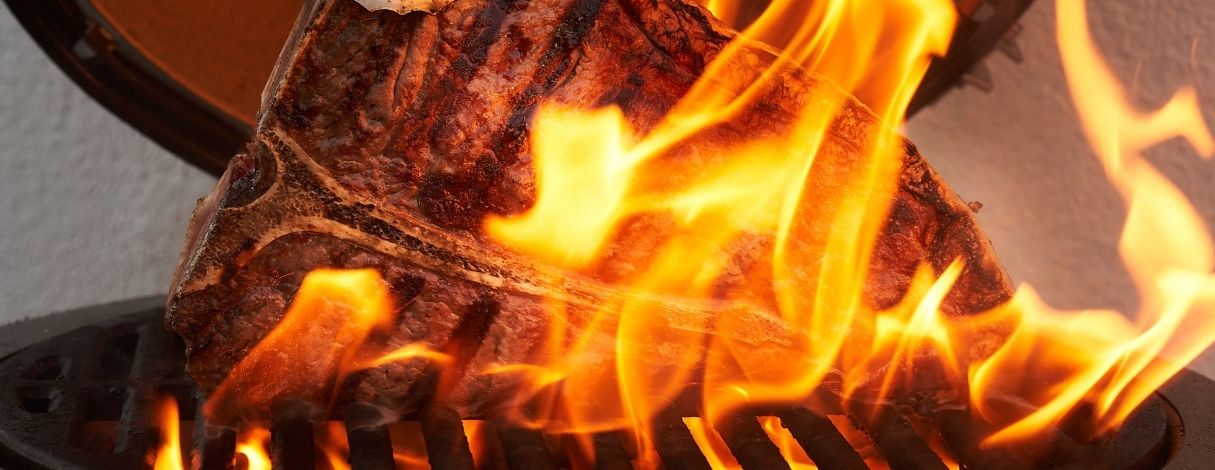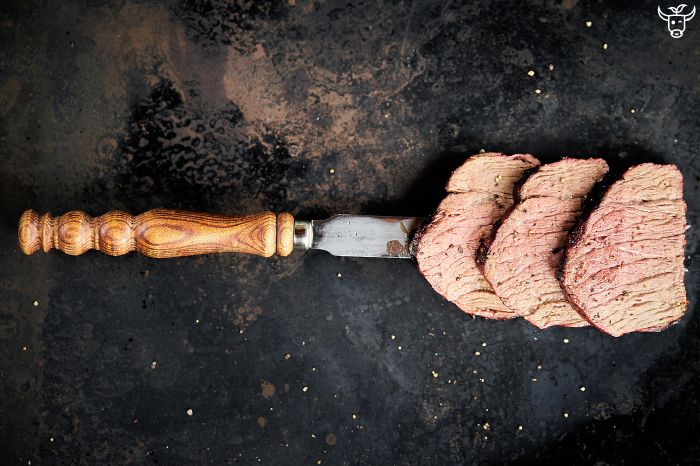

Themen
Meistgelesene Artikel
- Homemade New York Style Pastrami Sandwich
- Homemade New York Style Pastrami Sandwich
- Homemade New York Style Pastrami Sandwich
- Homemade New York Style Pastrami Sandwich
- Osterschmankerl & Bräuche: Alles rund um das Osterfest
- Dry-Aged Beef: Genusserlebnis durch gezielte Fleischreifung
- Ganslzeit: Martini Gansl richtig zubereiten | Rezept
Grilling steak properly: Everything you need to know
Our barbecue heroes - these are the best steaks for the barbecue
Not all steaks are the same and, above all, not all steaks are suitable for the grill. That's why we're revealing our absolute favourites, which are a steak-tastic treat on the hot grill.
The top 5 steaks for the barbecue
The finest cuts of beef are known to come from the back. These include:
- Ribeye steak (entrecote)
- Rump steak
- T-bone steak
- Porterhouse steak
- Tomahawk steak
But other cuts of beef are also ideal for grilling:
- Picanha
- Denver Cut
- Chuck Steak
All these cuts are a real treat and definitely belong to the crème de la crème. With a fabulous flavour of their own, wonderful roasted aromas and an incomparably beautiful marbling, they become a fabulous pleasure.
This is also extremely important when it comes to a perfectly grilled steak. Because the even distribution of the intramuscular fat in the meat is essential for a juicy and tender grilled result.
The preparation aka the preheating of the grill
Before your favourite cuts can be put on the barbecue, there are a few important points to bear in mind: barbecue professionals know that the right preparation is the be-all and end-all. We tell you what you should pay attention to before you even fire up the grill.
What is the best way to prepare my steak?
Just like the atmosphere at a party, our meat first needs to warm up a bit - namely to room temperature.
Room temperature for steak - the basic question
Should the steak come to room temperature, or should it go straight from the fridge onto the hot grill? In order to achieve a perfect result and, above all, to be able to grill according to the instructions, it is indeed advisable to let the meat come to room temperature beforehand. Therefore, it should be taken out of the refrigerator about 2 - 3 hours beforehand
Exceptions prove the rule:
Yes, not only in the French course, but also in the barbecue school there are exceptions. If you are about to enjoy a Wagyu steak, it should be taken straight from the fridge. Why? Because of the high marbling level, the meat should definitely go onto the grill cold, otherwise it would "melt".
Grilling steaks: The right thickness
A Blattal, a Scheiberl, a Stücker, a Trumm - yes, what is the right thickness for a perfect steak now? It is certainly a matter of taste, but it should never be cut too thin.
However, the right thickness of the meat also depends on the grill model: because a gas grill needs different meat thicknesses than an electric grill.
If you want to prepare a fist-thick tomahawk steak on a low-power electric grill, for example, you will find it difficult to achieve the desired grill aromas. The grill's power is simply too weak for that. If no gas or top-heat grill is available, you can alternatively hold the meat over a kindling chimney to create a crust before it is cooked in the closed grill.
Example:
Steaks with a thickness of 2 cm are therefore ready much faster on a wood grill than thicker pieces. It can easily happen that you overlook the cooking time. A beef steak should therefore be cut about 3 - 5 cm thick.
These pieces of meat are also ideal for a gas barbecue. First sear as usual and then finish cooking in the indirect grilling zone.
.jpg)
It's getting hot - seasoning steaks properly
Now it's really about your own taste - because the seasoning is up to you. In general, however, the following applies to beef in particular: less is more! Elaborate marinades would only drown out the meat's own flavour, and we don't want that.
With high-quality premium meat from Fitmeat, a pinch of coarse sea salt and some pepper is enough to give the meat the desired extra kick. But that's all it takes. While the grill is preheating, the meat can be salted, ideally about 20 - 30 minutes before it is placed on the grill.
This allows the flavours to develop without drawing out too much liquid and keeps the steak nice and juicy. Please wait with pepper until after grilling, otherwise you will only have a few charred flakes on the meat and the steak will be bitter.
On the grill, ready, go
Finally the time has come, all the preparations have been made, the grill is hot, the meat is at room temperature - you're ready to go.
How long does my steak have to be on the grill?
Timing is everything, so apart from real meat quality of course - but that's of little use if you accidentally let your steak get charred. Both the grilling process itself and the seasoning cause the meat to lose liquid. This should definitely be taken into account in the cooking time.
Whether rare, medium or well-done, in our overview we show you how long the steak should be on the grill.
.jpg)
Searing a steak - How it's guaranteed to work
For the so-called branding, you need pretty strong heat, and we mean really strong. Only at a minimum of 140°C can the beloved roasted aromas develop. This is known as the Maillard reaction, also called the browning reaction.
The myth about pores
In a nutshell: No, meat does not have pores, it has fibres. So the statement that the pores could close at high heat and keep the meat juices from leaking out is false. Even a really firm crust would not prevent the liquid from doing so.
Speaking of high heat, that's what searing is all about. The higher, the better. From about 500 °C, the steak gets warm around the heart. The higher the temperature when searing the steak, the smaller the edge of the roast in the end result.
At particularly high temperatures, however, the steak stays on the grill for a much shorter time. After all, we want it nicely browned, not burnt.
Steaks and their cooking times
After the steak has been seared nice and hot, it's off to the indirect zone. A particularly juicy steak needs temperatures of around 110 - 140 °C for this.
But sous-vide cooking is also an ideal method. The meat is wrapped in a vacuum bag and pre-cooked in a water bath at about 50°C. It tastes delicious, but takes time. It tastes delicious, but takes a little longer - 3 - 6 hours including the resting time. The meat is then patted dry and seared over a very high heat for about 30 seconds.
.jpg)
What core temperature should my steak have?
To grill a steak to perfection, it needs the ideal core temperature. If you prefer medium-rare, you should aim for 52 - 54 °C; medium is about 54 - 58 °C. Rare, i.e. really well-cooked meat, has a core temperature of 47 - 51 °C. You can find the exact overview in our table!
Alternative trick for the ideal cooking level
You don't have a thermometer with you? Then there's a pretty cool trick. All you need is the palm of your hand, which is always handy.
The right cut - the grand finale
What do I have to keep in mind when cutting the steak?
You have a knack for timing and your steak is cooked to perfection? Perfect, congratulations at this point! Now it's time for the grand finale. The ideal cut, because in the end it can be decisive.
After grilling, the meat should rest for at least 5 minutes. A cutting board in the warm kitchen on which the steak can lie open is sufficient for this. The meat should not be covered here, otherwise it will overcook.
During the resting phase, the core temperature rises by another 2 - 3 °C, so it is better to take it off the grill a little earlier.
In this case, there is only one correct direction, and that is against the fibres! Not with, not parallel, no against! If you want to find out the course, you can cut the steak in half in the middle. Then, and we say this again, carve against the fibres, ideally at a 90 °C angle.
Cut in this way, you have the short fibres and thus a wonderfully juicy meat. The perfect grilled steak!

